Inner Niger Delta Inundation Extent (2010–2022) Based on Landsat Imagery and the Google Earth Engine
Abstract
1. Introduction
2. Materials and Methods
2.1. Study Area
2.2. Flooding in the Inner Niger Delta
2.3. Remote Sensing Indices
2.4. Dataset and Training Sample Collection
- Cloudless composites (Landsat 5, 7, 8, and 9). Seasonal composites (September–December) computed from Landsat Collection 2, Level 2 datasets. These were mainly used for sample collection and classification. In other terms, the composited image for the September–December period of each year was derived from the image collections collected for each classification year. Cloud and cloud-shadow cover were masked out using the quality assurance (QA) products (QA_PIXEL and QA_RADSAT) provided with Landsat scenes. These products contain quality statistics gathered from the image data and cloud-mask information.
- JRC Global Surface Water Mapping Layers. These layers were used to easily differentiate the water-covered areas from other land-cover classes and to verify the sampling location of the water class.
- ESA WorldCover 2020, 2021. Developed by the European Space Agency (ESA), these are global land-cover maps for 2020 and 2021 at 10 m resolution based on Sentinel-1 and Sentinel-2 data.
- ESRI Landcover 2020. This was developed by ESRI using a deep learning AI land-classification model and by processing over 400,000 Earth observations (Sentinel-2).
- Dynamic World V1 (2015–2022). This is a 10 m near-real-time (NRT) land use/land cover (LULC) dataset that includes class probabilities and label information for nine classes.
- Copernicus Global Land Cover Layers: CGLS-LC100 Collection 3 (2015–2020). This is a new product in the portfolio of the Copernicus Global Land Service (CGLS) and delivers a global land-cover map at a 100 m spatial resolution, derived from the PROBA-V 100 m time series.
2.5. Computing Platform and Classifier Description
2.6. Correlation Analyses and Validation
2.7. Evaluating the Impact of Water Abstraction
3. Results
3.1. Ability of Remote Sensing Methods to Discriminate Flooded Areas
3.2. Spatial Patterns of the Inundation
3.3. Inter Annual Variability
3.4. Consistency with Mopti Discharge
3.5. Impact of Water Withdrawal on the Inundation Extent
4. Discussion
5. Conclusions
Author Contributions
Funding
Data Availability Statement
Acknowledgments
Conflicts of Interest
References
- Deng, Y.; Jiang, W.; Tang, Z.; Ling, Z.; Wu, Z. Long-Term Changes of Open-Surface Water Bodies in the Yangtze River Basin Based on the Google Earth Engine Cloud Platform. Remote Sens. 2019, 11, 2213. [Google Scholar] [CrossRef]
- Clarkson, B.R.; Ausseil, A.-G.E.; Gerbeaux, P. Wetland Ecosystem Services. Ecosyst. Serv. N. Z. Cond. Trends Manaaki Whenua Press Linc. 2013, 1, 192–202. [Google Scholar]
- Moser, M.; Prentice, C.; Frazier, S. A Global Overview of Wetland Loss and Degradation. In Proceedings of the 6th Meeting of the Conference of the Contracting Parties to the Ramsar Convention on Wetlands, Brisbane, Australia, 19 March 1996. [Google Scholar]
- Secretariat CBD. World Wetlands Day Monday, 2 February 2015: Wetlands for Our Future; United Nations Convention on Biological Diversity (CBD): Montreal, QC, Canada, 2015. [Google Scholar]
- Pekel, J.-F.; Cottam, A.; Gorelick, N.; Belward, A.S. High-resolution mapping of global surface water and its long-term changes. Nature 2016, 540, 418–422. [Google Scholar] [CrossRef] [PubMed]
- Liang, J.; Liu, D. Automated Estimation of Daily Surface Water Fraction from MODIS and Landsat Images Using Gaussian Process Regression. Int. J. Remote Sens. 2021, 42, 4261–4283. [Google Scholar] [CrossRef]
- Wang, R.; Xia, H.; Qin, Y.; Niu, W.; Pan, L.; Li, R.; Zhao, X.; Bian, X.; Fu, P. Dynamic Monitoring of Surface Water Area during 1989–2019 in the Hetao Plain Using Landsat Data in Google Earth Engine. Water 2020, 12, 3010. [Google Scholar] [CrossRef]
- Wang, R.; Pan, L.; Niu, W.; Li, R.; Zhao, X.; Bian, X.; Yu, C.; Xia, H.; Chen, T. Monitoring the Spatiotemporal Dynamics of Surface Water Body of the Xiaolangdi Reservoir Using Landsat-5/7/8 Imagery and Google Earth Engine. Open Geosci. 2021, 13, 1290–1302. [Google Scholar] [CrossRef]
- Wang, W.; Teng, H.; Zhao, L.; Han, L. Long-Term Changes in Water Body Area Dynamic and Driving Factors in the Middle-Lower Yangtze Plain Based on Multi-Source Remote Sensing Data. Remote Sens. 2023, 15, 1816. [Google Scholar] [CrossRef]
- Xia, H.; Zhao, J.; Qin, Y.; Yang, J.; Cui, Y.; Song, H.; Ma, L.; Jin, N.; Meng, Q. Changes in Water Surface Area during 1989–2017 in the Huai River Basin Using Landsat Data and Google Earth Engine. Remote Sens. 2019, 11, 1824. [Google Scholar] [CrossRef]
- Diepkilé, A.T.; Egon, F.; Blarel, F.; Mougin, E.; Frappart, F. Validation of the Altimetry-Based Water Levels from Sentinel-3A and B in the Inner Niger Delta. Proc. Int. Assoc. Hydrol. Sci. 2021, 384, 31–35. [Google Scholar] [CrossRef]
- Jiang, W.; Ni, Y.; Pang, Z.; Li, X.; Ju, H.; He, G.; Lv, J.; Yang, K.; Fu, J.; Qin, X. An Effective Water Body Extraction Method with New Water Index for Sentinel-2 Imagery. Water 2021, 13, 1647. [Google Scholar] [CrossRef]
- Sekertekin, A. Potential of Global Thresholding Methods for the Identification of Surface Water Resources Using Sentinel-2 Satellite Imagery and Normalized Difference Water Index. J. Appl. Remote Sens. 2019, 13, 044507. [Google Scholar] [CrossRef]
- Aires, F.; Papa, F.; Prigent, C.; Crétaux, J.-F.; Berge-Nguyen, M. Characterization and Space–Time Downscaling of the Inundation Extent over the Inner Niger Delta Using GIEMS and MODIS Data. J. Hydrometeorol. 2014, 15, 171–192. [Google Scholar] [CrossRef]
- Bergé-Nguyen, M.; Crétaux, J.-F. Inundations in the Inner Niger Delta: Monitoring and Analysis Using MODIS and Global Precipitation Datasets. Remote Sens. 2015, 7, 2127–2151. [Google Scholar] [CrossRef]
- Ogilvie, A.; Belaud, G.; Delenne, C.; Bailly, J.-S.; Bader, J.-C.; Oleksiak, A.; Ferry, L.; Martin, D. Decadal Monitoring of the Niger Inner Delta Flood Dynamics Using MODIS Optical Data. J. Hydrol. 2015, 523, 368–383. [Google Scholar] [CrossRef]
- Davranche, A.; Lefebvre, G.; Poulin, B. Wetland Monitoring Using Classification Trees and SPOT-5 Seasonal Time Series. Remote Sens. Environ. 2010, 114, 552–562. [Google Scholar] [CrossRef]
- Du, J.; Feng, X.; Wang, Z.; Huang, Y.; Ramadan, E. The Methods of Extracting Water Information from Spot Image. Chin. Geogr. Sci. 2002, 12, 68–72. [Google Scholar] [CrossRef]
- Li, Y.; Niu, Z. Systematic Method for Mapping Fine-Resolution Water Cover Types in China Based on Time Series Sentinel-1 and 2 Images. Int. J. Appl. Earth Obs. Geoinf. 2022, 106, 102656. [Google Scholar] [CrossRef]
- Menarguez, M. Global Water Body Mapping from 1984 to 2015 Using Global High Resolution Multispectral Satellite Imagery; University of Oklahoma: Norman, OK, USA, 2015. [Google Scholar]
- Davids, L.; Bekkema, M.; Zwarts, L.; Grigoras, I. An Improved Spatial Flooding Model of the Inner Niger Delta. A&W-Report; Altenburg & Wymenga Ecologisch Onderzoek: Feanwâlden, The Netherlands, 2018; p. 33. [Google Scholar]
- McFeeters, S.K. The Use of the Normalized Difference Water Index (NDWI) in the Delineation of Open Water Features. Int. J. Remote Sens. 1996, 17, 1425–1432. [Google Scholar] [CrossRef]
- Gao, B.-C. NDWI—A Normalized Difference Water Index for Remote Sensing of Vegetation Liquid Water from Space. Remote Sens. Environ. 1996, 58, 257–266. [Google Scholar] [CrossRef]
- Yang, L.; Driscol, J.; Sarigai, S.; Wu, Q.; Chen, H.; Lippitt, C.D. Google Earth Engine and Artificial Intelligence (Ai): A Comprehensive Review. Remote Sens. 2022, 14, 3253. [Google Scholar] [CrossRef]
- Acharya, T.D.; Subedi, A.; Lee, D.H. Evaluation of Machine Learning Algorithms for Surface Water Extraction in a Landsat 8 Scene of Nepal. Sensors 2019, 19, 2769. [Google Scholar] [CrossRef]
- Li, X.; Zhang, F.; Chan, N.W.; Shi, J.; Liu, C.; Chen, D. High Precision Extraction of Surface Water from Complex Terrain in Bosten Lake Basin Based on Water Index and Slope Mask Data. Water 2022, 14, 2809. [Google Scholar] [CrossRef]
- Ibrahim, M.; Wisser, D.; Ali, A.; Diekkrüger, B.; Seidou, O.; Mariko, A.; Afouda, A. Water Balance Analysis over the Niger Inland Delta-Mali: Spatio-Temporal Dynamics of the Flooded Area and Water Losses. Hydrology 2017, 4, 40. [Google Scholar] [CrossRef]
- Mahé, G.; Orange, D.; Mariko, A.; Bricquet, J. Estimation of the Flooded Area of the Inner Delta of the River Niger in Mali by Hydrological Balance and Satellite Data. Hydro-Climatol. Var. Chang. 2011, 344, 138–143. [Google Scholar]
- Cissé, S.; Gosseye, P.; Veeneklaas, F. Compétition Pour des Ressources Limitées: Le Cas de la Cinquième Région du Mali; CABO: Wageningen, The Netherlands, 1990; ISBN 90-73384-07-9. [Google Scholar]
- Mariko, A.; Mahé, G.; Orange, D.; Royer, A.; Nonguierma, A.; Amani, A.; Servat, E. Suivi des Zones d’Inondation du Delta Intérieur du Niger: Perspectives avec les Données de Basse Résolution NOAA/AVHRR. In Gestion Intégrée des Ressources Naturelles en Zones Inondables Tropicales; Orange, D.R., Arfi, M., Kuper, P., Morand, P., Eds.; B Témé; Research Institute for Development (IRD): Marseille, France, 2002; pp. 231–244. [Google Scholar]
- Zwarts, L.; Van Beukering, P.; Kone, B.; Wymenga, E. The Niger, a Lifeline. Effective Water Management in the Upper Niger Basin; RIZA: Lelystad, The Netherlands; Wetlands International: Sévaré, Mali, 2005. [Google Scholar]
- Leten, J.; Zwarts, L.; Sanogo, S.; Porna Koné, M.; Santara, D.L.; Diabaté, L.; Coulibaly, P. Etat des Lieux du Delta Intérieur—Vers une Vision Commune de Développement; Research Institute for Development: Paris, France, 2010.
- Liersch, S.; Cools, J.; Kone, B.; Koch, H.; Diallo, M.; Reinhardt, J.; Fournet, S.; Aich, V.; Hattermann, F.F. Vulnerability of Rice Production in the Inner Niger Delta to Water Resources Management under Climate Variability and Change. Environ. Sci. Policy 2013, 34, 18–33. [Google Scholar] [CrossRef]
- Keita, N.; Bélières, J.-F.; Sidibé, S. Extension de la Zone Aménagée de l’Office du Niger: Exploitation Rationnelle et Durable des Ressources Naturelles au Service d’un Enjeu National de Développement; Research Institute for Development: Paris, France, 2002.
- Gonet, C.; Stausee, K. Fiche Descriptive Sur Les Zones Humides Ramsar (FDR); Bureau de la Convention de Ramsar: Gland, Switzerland, 2004. [Google Scholar]
- Ajayi, O.C.; Diakit’e, N.; Konate, A.B.; Catacutan, D. Rapid Assessment of the Inner Niger Delta of Mali; ICRAF Working Paper No. 144; World Agroforestry Centre: Nairobi, Kenya, 2012. [Google Scholar]
- Flood, N. Seasonal Composite Landsat TM/ETM+ Images Using the Medoid (a Multi-Dimensional Median). Remote Sens. 2013, 5, 6481–6500. [Google Scholar] [CrossRef]
- Francini, S.; Hermosilla, T.; Coops, N.C.; Wulder, M.A.; White, J.C.; Chirici, G. An Assessment Approach for Pixel-Based Image Composites. ISPRS J. Photogramm. Remote Sens. 2023, 202, 1–12. [Google Scholar] [CrossRef]
- Feyisa, G.L.; Meilby, H.; Fensholt, R.; Proud, S.R. Automated Water Extraction Index: A New Technique for Surface Water Mapping Using Landsat Imagery. Remote Sens. Environ. 2014, 140, 23–35. [Google Scholar] [CrossRef]
- Hackman, K.O.; Li, X.; Asenso-Gyambibi, D.; Asamoah, E.A.; Nelson, I.D. Analysis of Geo-Spatiotemporal Data Using Machine Learning Algorithms and Reliability Enhancement for Urbanization Decision Support. Int. J. Digit. Earth 2020, 13, 1717–1732. [Google Scholar] [CrossRef]
- Yangouliba, G.I.; Zoungrana, B.J.-B.; Hackman, K.O.; Koch, H.; Liersch, S.; Sintondji, L.O.; Dipama, J.-M.; Kwawuvi, D.; Ouedraogo, V.; Yabré, S. Modelling Past and Future Land Use and Land Cover Dynamics in the Nakambe River Basin, West Africa. Model. Earth Syst. Environ. 2023, 9, 1651–1667. [Google Scholar] [CrossRef]
- Zhang, M.; Huang, H.; Li, Z.; Hackman, K.O.; Liu, C.; Andriamiarisoa, R.L.; Raherivelo, T.N.A.N.; Li, Y.; Gong, P. Automatic High-Resolution Land Cover Production in Madagascar Using Sentinel-2 Time Series, Tile-Based Image Classification and Google Earth Engine. Remote Sens. 2020, 12, 3663. [Google Scholar] [CrossRef]
- Tucker, C.J. Red and Photographic Infrared Linear Combinations for Monitoring Vegetation. Remote Sens. Environ. 1979, 8, 127–150. [Google Scholar] [CrossRef]
- Zha, Y.; Gao, J.; Ni, S. Use of Normalized Difference Built-up Index in Automatically Mapping Urban Areas from TM Imagery. Int. J. Remote Sens. 2003, 24, 583–594. [Google Scholar] [CrossRef]
- Shen, L.; Li, C. Water Body Extraction from Landsat ETM+ Imagery Using Adaboost Algorithm. In Proceedings of the 2010 18th International Conference on Geoinformatics, Beijing, China, 18–20 June 2010; pp. 1–4. [Google Scholar]
- Xu, H. Modification of Normalised Difference Water Index (NDWI) to Enhance Open Water Features in Remotely Sensed Imagery. Int. J. Remote Sens. 2006, 27, 3025–3033. [Google Scholar] [CrossRef]
- Huete, A.R. A Soil-Adjusted Vegetation Index (SAVI). Remote Sens. Environ. 1988, 25, 295–309. [Google Scholar] [CrossRef]
- Huete, A.; Didan, K.; Miura, T.; Rodriguez, E.P.; Gao, X.; Ferreira, L.G. Overview of the Radiometric and Biophysical Performance of the MODIS Vegetation Indices. Remote Sens. Environ. 2002, 83, 195–213. [Google Scholar] [CrossRef]
- Chen, W.; Liu, L.; Zhang, C.; Wang, J.; Wang, J.; Pan, Y. Monitoring the Seasonal Bare Soil Areas in Beijing Using Multitemporal TM Images. In Proceedings of the 2004—IGARSS ’04, IEEE International Geoscience and Remote Sensing Symposium, Anchorage, AK, USA, 20–24 September 2004; Volume 5, pp. 3379–3382. [Google Scholar]
- Ding, F. Study on Information Extraction of Water Body with a New Water Index (NWI). Sci. Surv. Mapp 2009, 34, 155–158. [Google Scholar]
- Breiman, L. Random Forests. Mach. Learn. 2001, 45, 5–32. [Google Scholar] [CrossRef]
- Mas, J.-F.; Pérez-Vega, A.; Ghilardi, A.; Martínez, S.; Loya-Carrillo, J.O.; Vega, E. A Suite of Tools for Assessing Thematic Map Accuracy. Geogr. J. 2014, 2014, 372349. [Google Scholar] [CrossRef]
- Cohen, J. A Coefficient of Agreement for Nominal Scales. Educ. Psychol. Meas. 1960, 20, 37–46. [Google Scholar] [CrossRef]
- Zwarts, L. Will the Inner Niger Delta Shrivel up Due to Climate Change and Water Use Upstream? A&W Report; Altenburg & Wymenga Ecologisch Onderzoek: Feanwâlden, The Netherlands, 2010; p. 31. [Google Scholar]
- Haque, M.M.; Seidou, O.; Mohammadian, A.; Djibo, A.G. Development of a Time-Varying MODIS/2D Hydrodynamic Model Relationship between Water Levels and Flooded Areas in the Inner Niger Delta, Mali, West Africa. J. Hydrol. Reg. Stud. 2020, 30, 100703. [Google Scholar] [CrossRef]
- Tran, B.; Mul, M.; Seyoum, S.; Wymenga, E. Monitoring Wetlands Dynamics in the Inner Niger Delta Using Open-Access Remotely Sensend Evapotranspiration Data. In Proceedings of the 39th IAHR World Congress, Granada, Spain, 19 June 2022. [Google Scholar]
- OPIDIN. Flood in the Inner Niger Delta Reach Highest Peak; Bulletin 24 October 2022; Wetlands International Mali Office: Bamako, Mali, 2022; p. 1. [Google Scholar]
- Kuper, M.; Hassane, A.; Orange, D.; Chohin-Kuper, A.; Sow, M. Régulation, Utilisation et Partage Des Eaux Du Fleuve Niger: Impact de La Gestion Des Aménagements Hydrauliques; Research Institute for Development (IRD): Paris, France, 2002.
- Morand, P.; Kodio, A.; Andrew, N.; Sinaba, F.; Lemoalle, J.; Béné, C. Vulnerability and Adaptation of African Rural Populations to Hydro-Climate Change: Experience from Fishing Communities in the Inner Niger Delta (Mali). Clim. Chang. 2012, 115, 463–483. [Google Scholar] [CrossRef]
- Thompson, J.R.; Crawley, A.; Kingston, D.G. Future River Flows and Flood Extent in the Upper Niger and Inner Niger Delta: GCM-Related Uncertainty Using the CMIP5 Ensemble. Hydrol. Sci. J. 2017, 62, 2239–2265. [Google Scholar] [CrossRef]
- Laë, R.; Mahé, G. Crue, Inondation et Production Halieutique. Un Modèle Prédictif Des Captures Dans Le Delta Intérieur Du Niger. In Gestion Intégrée des Ressources Naturelles en Zones Inondables Tropicales; Research Institute for Development (IRD): Paris, France, 2002. [Google Scholar]
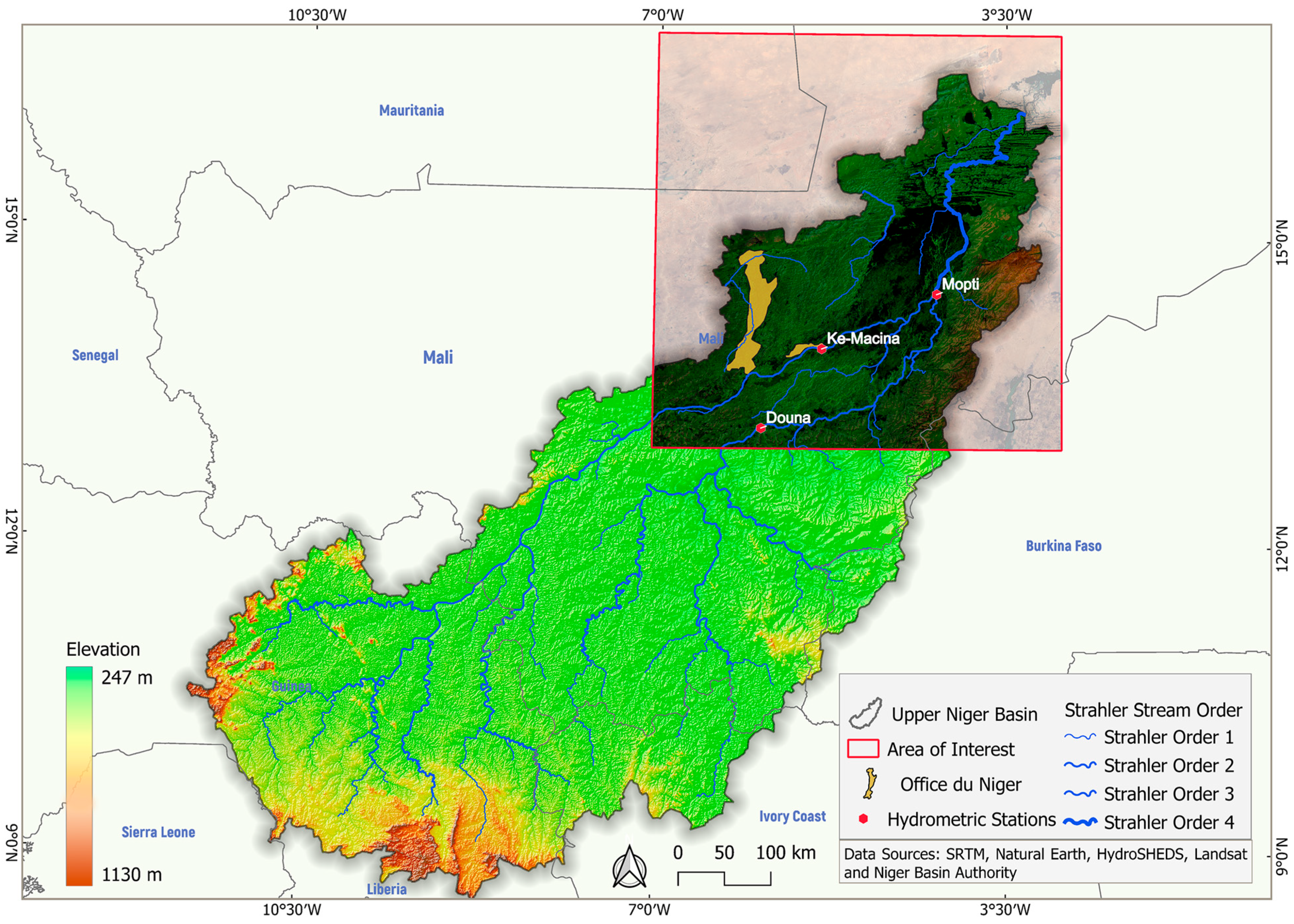
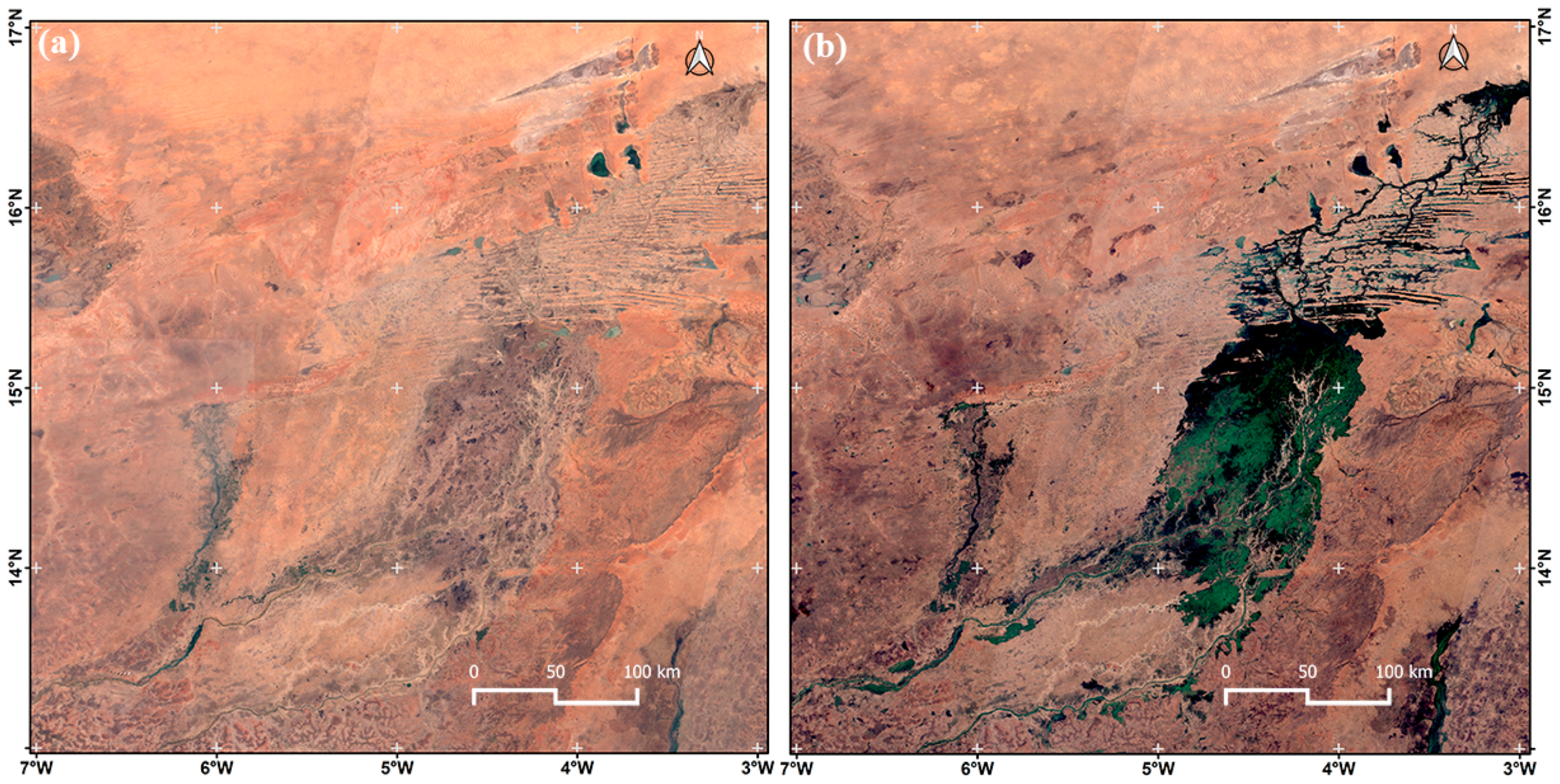
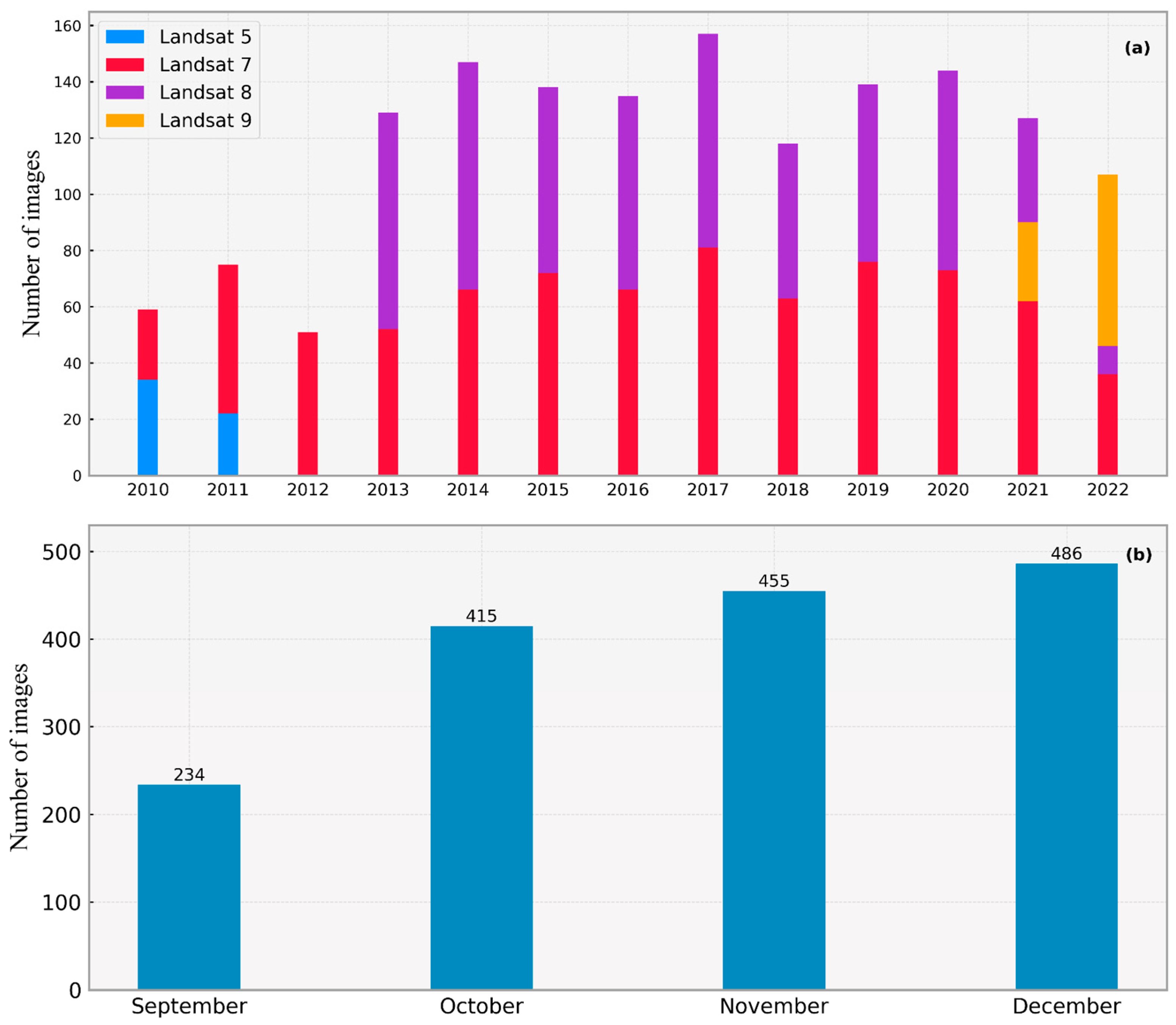

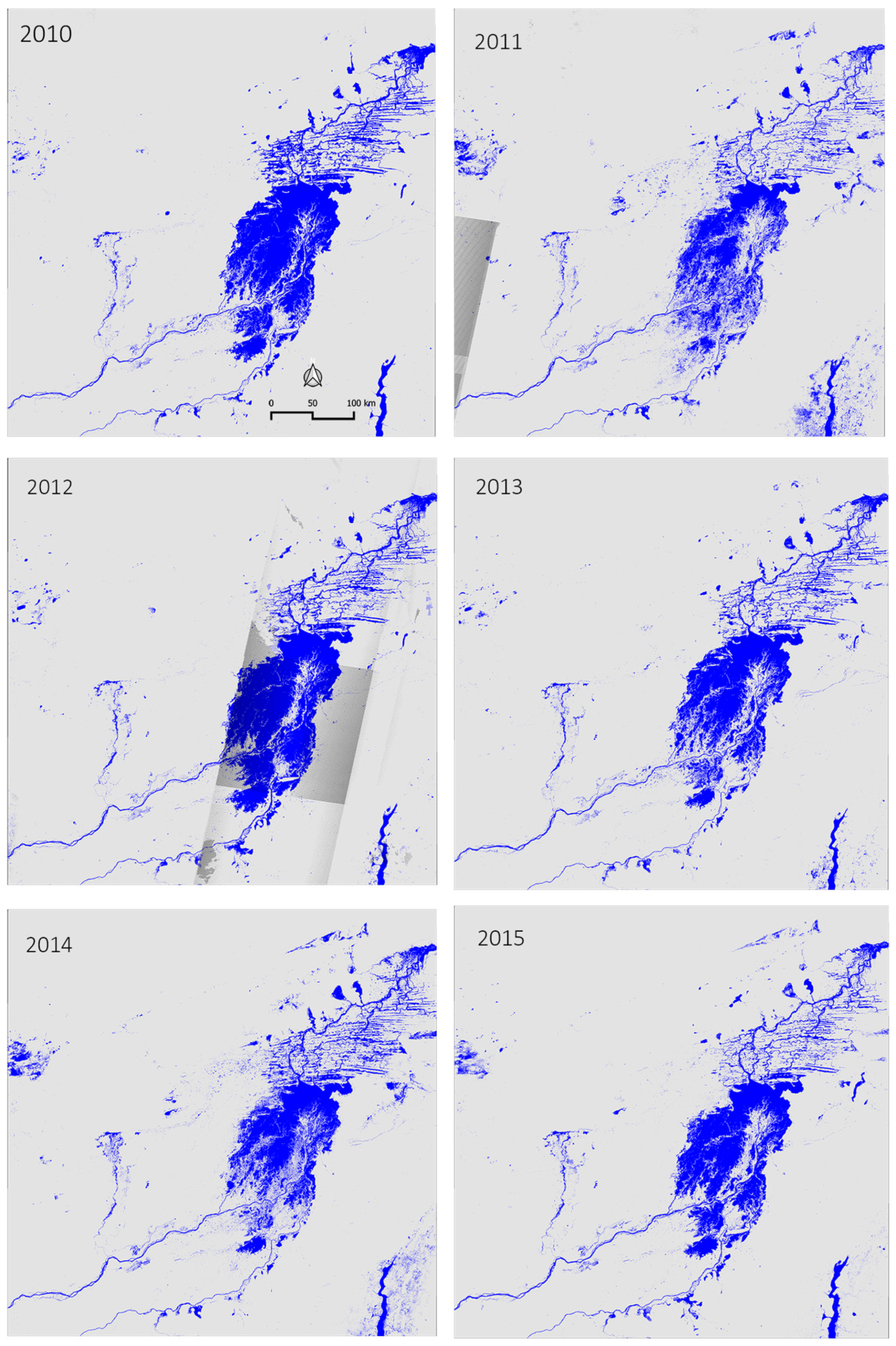
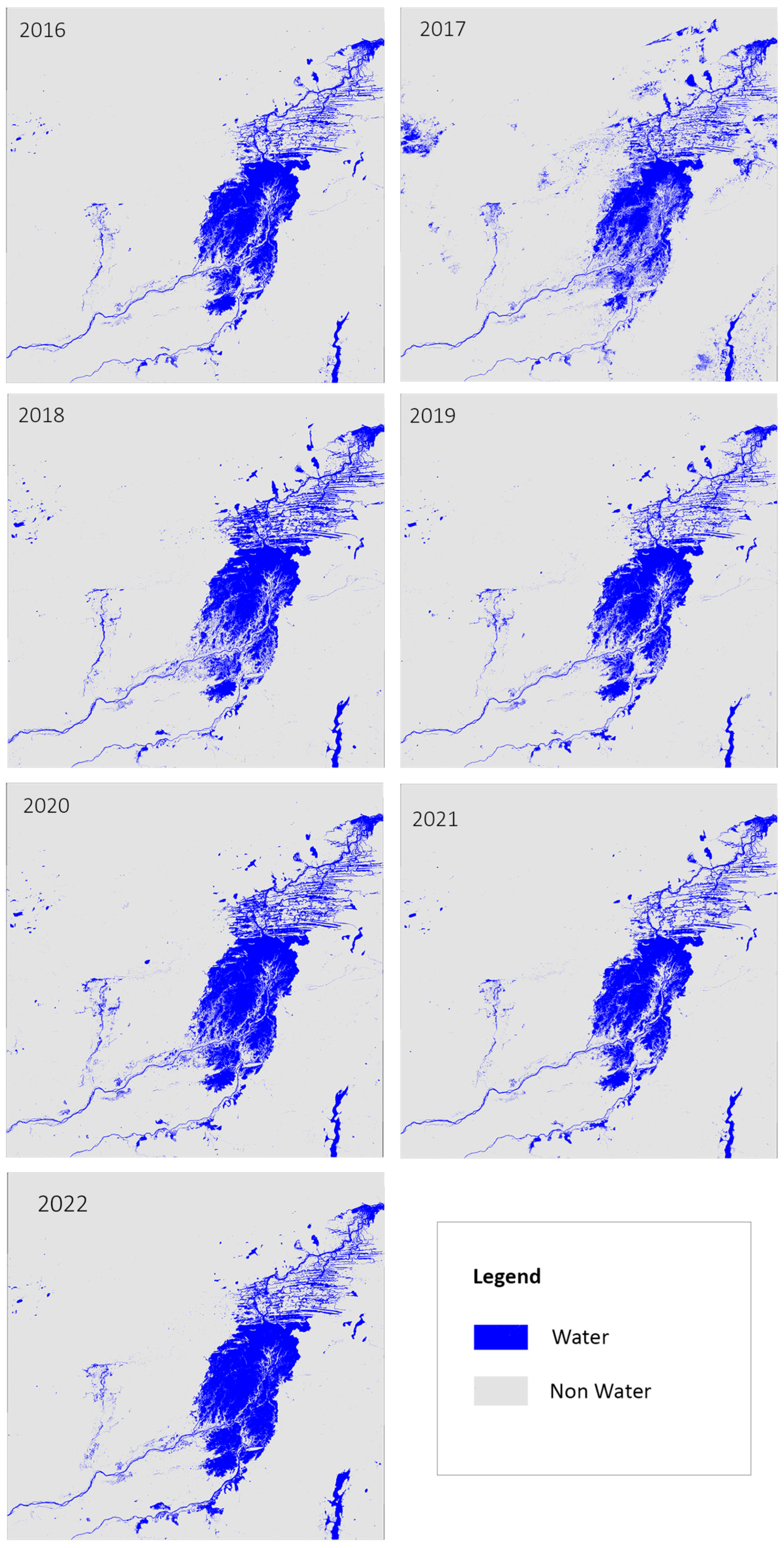
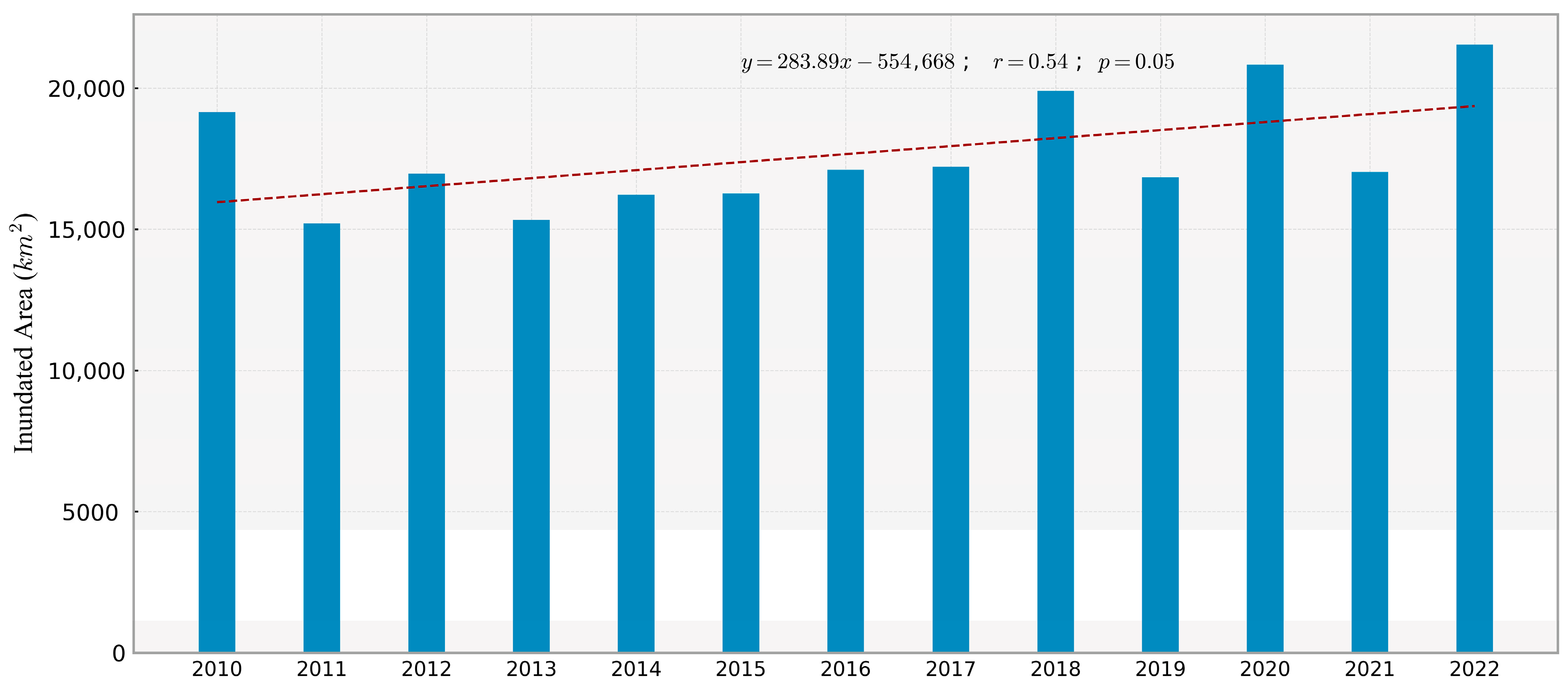
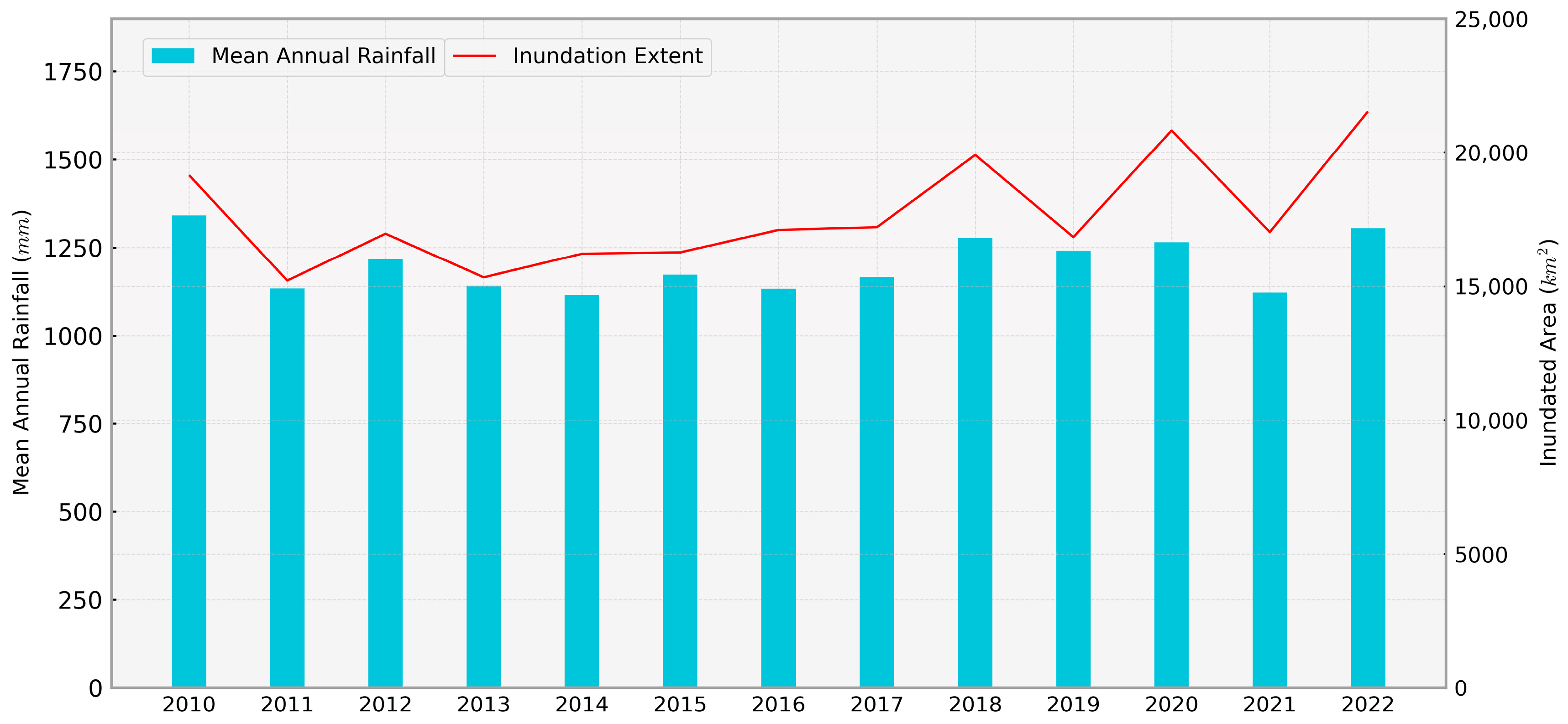

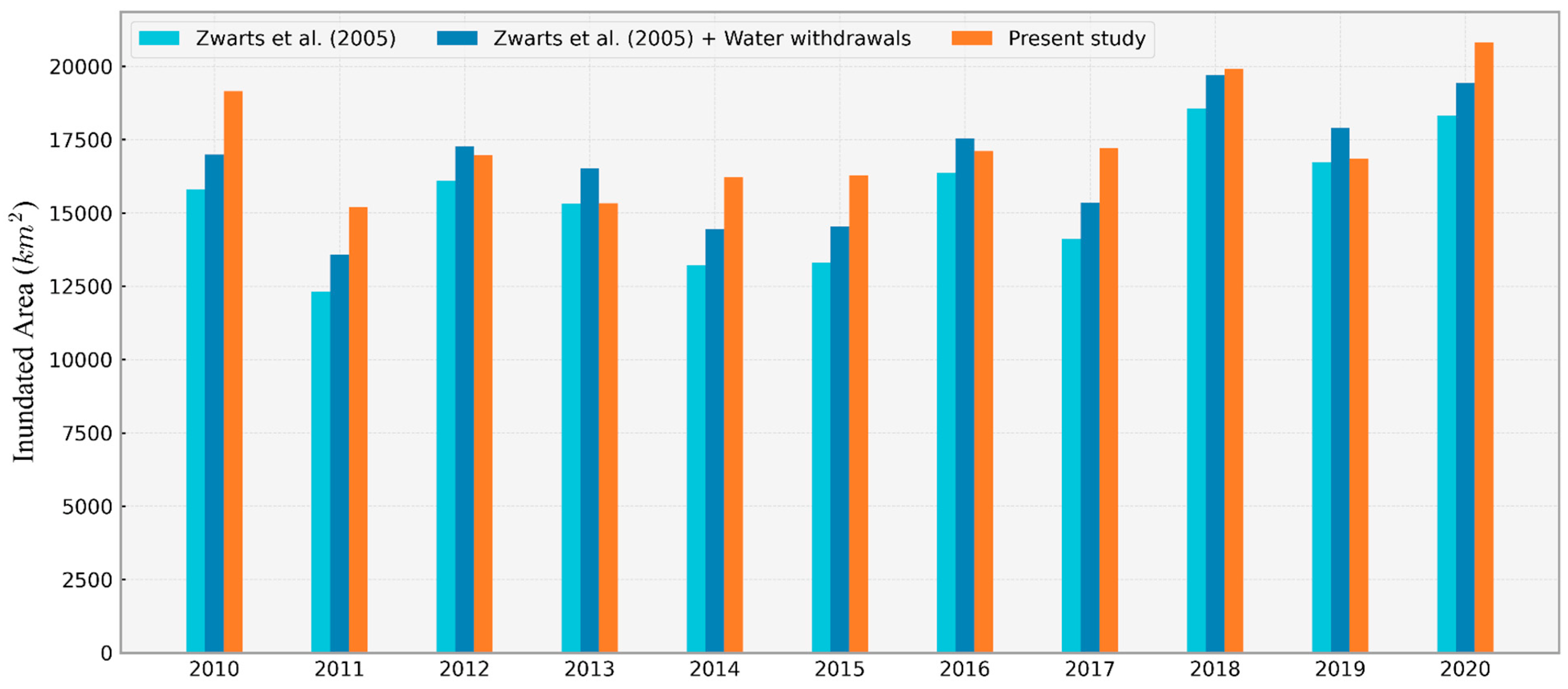
| Band No | Description | Resolution (m) | Computation | Reference |
|---|---|---|---|---|
| 0 | Blue | 30 | Medoid from September to December | [37] |
| 1 | Green | 30 | Medoid from September to December | [37] |
| 2 | Red | 30 | Medoid from September to December | [37] |
| 3 | NIR | 30 | Medoid from September to December | [37] |
| 4 | SWIR1 | 30 | Medoid from September to December | [37] |
| 5 | SWIR2 | 30 | Medoid from September to December | [37] |
| 6 | NDVI | 30 | (NIR − Red)/(NIR + Red) | [43] |
| 7 | NDMI | 30 | (NIR − SWIR1)/(NIR + SWIR1) | [23] |
| 8 | NDBI | 30 | (SWIR1 − NIR)/(SWIR1 + NIR) | [44] |
| 9 | WRI | 30 | (Green + Red)/(NIR + SWIR1) | [45] |
| 10 | MNDWI | 30 | (Green − SWIR1)/(Green + SWIR1) | [22,46] |
| 11 | SAVI | 30 | 1.5 × [(NIR − RED)/(NIR + RED + 0.5)] | [47] |
| 12 | EVI | 30 | 2.5 × (NIR − Red)/(NIR + 6.0 × RED − 7.5 × Blue + 1.0) | [48] |
| 13 | AWEI | 30 | Blue + 2.5 × Green − 1.5 × (NIR + SWIR1) − 0.25 × SWIR2 | [39] |
| 14 | BSI | 30 | [(Red + SWIR1) − (NIR + Blue)]/[(Red + SWIR1) + (NIR + Blue)] | [49] |
| 15 | NWI | 30 | [(Blue − NIR) − (Swir1 + Swir2)]/[(Blue + NIR) + (Swir1 + Swir2)] | [50] |
| 16 | Elevation | 30 | NASA SRTM Digital Elevation 30 m | |
| 17 | Slope | 30 | Derived from the Digital Elevation Model |
| Year | Without Indices | With Indices | Maximum Inundation Extent (km2) | ||
|---|---|---|---|---|---|
| Overall Accuracy (%) | Kappa Coefficient (%) | Overall Accuracy (%) | Kappa Coefficient (%) | ||
| 2010 | 96.2 | 91.5 | 97.9 | 95.7 | 19,149 |
| 2011 | 92.8 | 85.6 | 96.5 | 93.0 | 15,209 |
| 2012 | 95.0 | 89.9 | 98.0 | 95.6 | 16,967 |
| 2013 | 95.0 | 89.9 | 97.8 | 95.4 | 15,331 |
| 2014 | 92.0 | 84.0 | 97.2 | 94.4 | 16,217 |
| 2015 | 94.6 | 89.2 | 97.5 | 95.1 | 16,269 |
| 2016 | 94.9 | 89.9 | 97.4 | 94.8 | 17,104 |
| 2017 | 91.2 | 82.4 | 96.4 | 92.8 | 17,210 |
| 2018 | 96.1 | 92.2 | 98.0 | 96.1 | 19,903 |
| 2019 | 95.8 | 91.5 | 97.7 | 95.4 | 16,839 |
| 2020 | 97.1 | 90.1 | 97.7 | 95.4 | 20,823 |
| 2021 | 95.3 | 90.5 | 98.2 | 96.4 | 17,025 |
| 2022 | 96.6 | 89.1 | 97.6 | 95.1 | 21,536 |
Disclaimer/Publisher’s Note: The statements, opinions and data contained in all publications are solely those of the individual author(s) and contributor(s) and not of MDPI and/or the editor(s). MDPI and/or the editor(s) disclaim responsibility for any injury to people or property resulting from any ideas, methods, instructions or products referred to in the content. |
© 2024 by the authors. Licensee MDPI, Basel, Switzerland. This article is an open access article distributed under the terms and conditions of the Creative Commons Attribution (CC BY) license (https://creativecommons.org/licenses/by/4.0/).
Share and Cite
Bonkoungou, B.; Bossa, A.Y.; van der Kwast, J.; Mul, M.; Sintondji, L.O. Inner Niger Delta Inundation Extent (2010–2022) Based on Landsat Imagery and the Google Earth Engine. Remote Sens. 2024, 16, 1853. https://doi.org/10.3390/rs16111853
Bonkoungou B, Bossa AY, van der Kwast J, Mul M, Sintondji LO. Inner Niger Delta Inundation Extent (2010–2022) Based on Landsat Imagery and the Google Earth Engine. Remote Sensing. 2024; 16(11):1853. https://doi.org/10.3390/rs16111853
Chicago/Turabian StyleBonkoungou, Benjamin, Aymar Yaovi Bossa, Johannes van der Kwast, Marloes Mul, and Luc Ollivier Sintondji. 2024. "Inner Niger Delta Inundation Extent (2010–2022) Based on Landsat Imagery and the Google Earth Engine" Remote Sensing 16, no. 11: 1853. https://doi.org/10.3390/rs16111853
APA StyleBonkoungou, B., Bossa, A. Y., van der Kwast, J., Mul, M., & Sintondji, L. O. (2024). Inner Niger Delta Inundation Extent (2010–2022) Based on Landsat Imagery and the Google Earth Engine. Remote Sensing, 16(11), 1853. https://doi.org/10.3390/rs16111853










